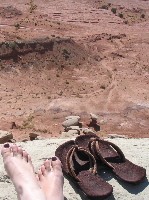Dots
I can't remember the last time I felt like everything in my life was simply going well. It's a strange and wonderful feeling. I highly recommend it.
Anyhow, seeing as how my paper was accepted by ApJ (the Astrophysical Journal) last night, I might as well start babbling about my next project with Kris Stanek.
The main goal of this project is to have something short, sweet, and fun, from which I can learn a lot and publish a paper. There are some near-infrared data lying around from 2000 through 2002 that some guys in our department took in order to look at one object, but they never got around to analyzing the rest of the data. So, we've got a bunch of images of the center of the Milky Way, and now we can look for variable sources, such as binary stars or pulsating stars or other crazy things. One of the exciting things about the cluster of stars at the center of the Galaxy is that there are both old and young stars (which is unusual---usually all of the stars in a cluster are the same age) and so there can be a lot of crazy stuff going on.
The way we are looking for variable stars is with a method called image subtraction. It's totally nuts that this works; we can often get fairly good light curves (graphs of how the brightness changes with time) of stars in regions so crowded that we can't even resolve the individual stars. To do this, we first make a reference image from some of the really good looking images in the set, and then subtract all of the other images from the reference (hence image subtraction). Stars that don't change in brightness ("vary") as time passes from image to image don't show up in the subtracted images, but ones whose brightnesses change do show up. We then, with the help of some black magic and code, can plot the light curves of the stars in the field.
Then comes the fun part. Lots of variable stars vary with some period; for instance, an eclipsing binary varies according to how long it takes for the two stars to go around one another. So, we just plop the data into a program and fiddle with it. This is what I spent this afternoon playing with. It's like connect-the-dots on steroids. The really fun part of it is playing with the phase-modulator, which folds the lightcurve up according to some phase, which I then get to futz around with.
The current plan is to have lightcurves for all of the sources in the field by tomorrow, or maybe Thursday. Not bad considering we started yesterday morning ...
And then I get to spend a month tweaking all sorts of parameters and redoing everything many many times and looking at lightcurves all squinty-eyed until I don't know left from right (I already don't know up from down) and we have everything all set. And much to Kris's chagrin, I don't think we'll actually have the paper finished by next Friday ...


1 comment:
Sounds wonderful! I'm glad you've got a project that you're so excited about!
Post a Comment